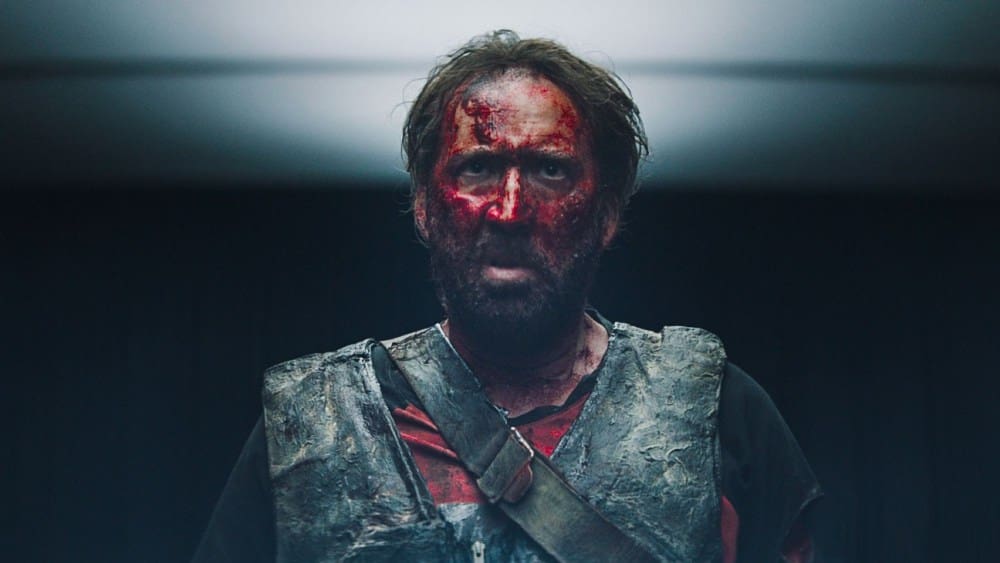
Strip a man of everything that makes his existence whole and pure and what do you get? A binary, feverish, and focused entity dead-set on one goal. Director Panos Cosmatos’s overall intent with the ’80s style-influenced Mandy is to answer that very question. Mandy is set in a very particular space of time within a very particular space of emotions. It’s an experience that is meant to appeal to the viewer at both the sensory and visceral levels.
Set in 1983 near the Shadow Mountains, Red (Nicolas Cage) and Mandy (Andrea Riseborough) live a quiet and simple life confined to the lush landscape of the wilderness. The tranquil settings of their environment codify their rocky, individual history. It’s hinted that Red has trouble with alcoholism. Mandy tells a story about her father and the killing of baby starlings. Where they have emotional and physical scars, they find solace within each other. More so Red, in how their story is set up. When they first have a discussion in their bedroom, you see a full galaxy.
This all changes once The Children of The New Dawn pass through and their leader with Buffalo Bill like tendencies, Jeremiah Sand (Linus Roache) sees Mandy and becomes obsessed with her. Without going too much into her backstory, the movie conveys that Mandy has a magnetism to the men around her. It goes from love to outright toxicity. Riseborough does a great job in showing this with her facial expressions during the slow camera shots.
There are parts of the movie that reveal themselves like acts that have animated titles. When you get to the 2nd and 3rd acts, that’s where the real depravity of this cult starts to show itself and its sinister motives for the couple. The cinematography by Benjamin Loebis conveys this in two ways. Loeb works together with Cosmatos’s vision to show the vastness of the wilderness, often in wide shots. Mandy does not have many characters, so they also make the movie very personal and restricted. It’s a confined story. You’ll see this in the over-the-shoulder shots of Red driving his car or how the camera focuses of Red’s non-verbal cues.
One of the standouts of this movie is the performance of Nicolas Cage as a man who has lost the thing that’s dear to him. Red’s descent into vengeful madness is a journey that takes us to one of the most powerful scenes. You don’t get to hear Red’s reaction as Mandy spoiler gets killed. Only the aftermath is shown, first with exhaustion and shock, and one of sadness and rage as he’s in the bathroom. It’s a very human transition that Cage does convincingly.
Mandy becomes the focal point for Jeremiah. His position as the head of this cult based on his telling that he was chosen by a higher power is very built on hyper-masculinity. When Mandy mocks that, Jeremiah begins to briefly doubt himself and he kills her to keep that aura. Before the execution scene, Roache executes a monologue with himself in a mirror where he portrays the human and “god complex” sides of himself which was subtle, but great.
There’s a real question of what’s real and what’s not. The drug use, LSD in particular, makes you question the validity of what you’re watching. Are there really bikers from hell? Are we in a hallucinogenic journey of something as simple as the casualty of loss and the internal makeup of cults? Cosmatos plays with the fringes of reality to where you can determine which route you can go.
Color is used in a spectacular way as an atmospheric plot device. When the Children of The New Dawn arrive in a scene, especially with Sand, they are engulfed in red light. As Red is going on his murderous recourse of revenge, red is usually trailing him. Strobes of color are utilized when the cult or the Black Skulls are doing something or arriving somewhere. The real instances of light are used in fire—a motif that comes up in two key parts of the movie. Fire is a “cleansing” agent. Jeremiah uses fire to clear the “instance” where his power was questioned. Red uses fire in the accumulation of his journey of retaliation.
Plot-wise, it’s two sides of the coin. You want to get more backstory on how The Children of The New Dawn came to be. You only get information on the Black Skulls briefly from Red’s friend Caruthers (Bill Duke). Other than that, motivations are very streamlined. Where the story of the movie is very straightforward, the aesthetics are there to try to fill in the grey areas. The score from the late Jóhann Jóhannsson does a great job in keeping the tension and also heightening the importance of the battles that Red goes through.
Mandy is a love letter to a time where horror movies had a combination of otherworldly visuals and contemporary special effects to show the sheer brutality of either revenge or evil. It’s a story of idolatry gone unchecked and a man’s fever for rage burning ever so bright on a collision course.
Rating: 7.9/10

